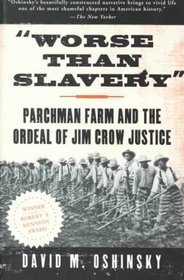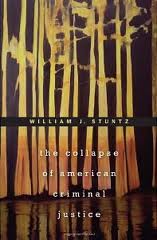I am taking a class entitled Race, Class, and Justice in the American South. I am required to write a response paper each week, here is my first one:
Worse Than Slavery: Parchman Farm and the Ordeal of Jim Crow Justice by David Oshinsky, The Collapse of American Criminal Justice by William Stuntz, and the PBS film entitled Slavery By Another Name dealt with the criminal justice system and race relations in America from Reconstruction until the present through their discussions of the black codes, sharecropping, peonage, the convict lease system, lynching, chain gangs, and attempts to reform the system.
 Oshinsky gave an excellent general account of the day-to-day struggles African-Americans prisoners had to endure in the South. By focusing on the infamous Mississippi prison called Parchman Farm, Oshinsky showed that the white leaders of Parchman were motivated by profits and enforcing their superiority over blacks rather than rehabilitating the criminals. The major strength of this book was that it showed the brutality that whites inflicted on the black prisoners. For instance, a white mob put dirt in the mouth of Charley Shepard, a black man, before they lit him on fire so he would burn alive and not die instantly from the fumes. Oshinsky explained that some whites treated blacks worse during the convict lease system compared to slavery because blacks were valuable commodities as slaves but they were expendable during the convict lease period since there was such a huge supply of convict laborers. Another strength of this book was to show the importance of labor history. Worse Than Slavery showed how the lives of black people were ruined when they got convicted on trumped up charges just so whites could force these prisoners to work for no pay on Parchman Farm for the enrichment of the whites. Oshinsky said white southerners were now using the criminal justice system to exert the same control over blacks as they had done previously during slavery. Another strength of this book was to highlight how people’s racial attitudes affected their thinking. For example, white prostitutes were pitied for being in an unfortunate circumstance but black prostitutes were more likely imprisoned.
Oshinsky gave an excellent general account of the day-to-day struggles African-Americans prisoners had to endure in the South. By focusing on the infamous Mississippi prison called Parchman Farm, Oshinsky showed that the white leaders of Parchman were motivated by profits and enforcing their superiority over blacks rather than rehabilitating the criminals. The major strength of this book was that it showed the brutality that whites inflicted on the black prisoners. For instance, a white mob put dirt in the mouth of Charley Shepard, a black man, before they lit him on fire so he would burn alive and not die instantly from the fumes. Oshinsky explained that some whites treated blacks worse during the convict lease system compared to slavery because blacks were valuable commodities as slaves but they were expendable during the convict lease period since there was such a huge supply of convict laborers. Another strength of this book was to show the importance of labor history. Worse Than Slavery showed how the lives of black people were ruined when they got convicted on trumped up charges just so whites could force these prisoners to work for no pay on Parchman Farm for the enrichment of the whites. Oshinsky said white southerners were now using the criminal justice system to exert the same control over blacks as they had done previously during slavery. Another strength of this book was to highlight how people’s racial attitudes affected their thinking. For example, white prostitutes were pitied for being in an unfortunate circumstance but black prostitutes were more likely imprisoned.
The major weakness of the book was that it emphasized breadth over depth. Oshinsky talked about many influential incidents, like the Emmitt Till case, over a long time span in only about 250 pages. It was worthwhile to receive a general overview but this book would have benefited from going more in depth on the specifics of these incidents. This would allow for multiple perspectives like an international perspective or from the point of view of the black family who was missing their husband/father. This book also suffered by not emphasizing national politics. In contrast, the Slavery by Another Name film mentioned Theodore Roosevelt’s influence on starting peonage trials in the South even though they were not completely successful. Oshinsky talked about how early 20th century historians said blacks regressed after they were freed but this book would have benefited from including more historiography. This would help the author explain what unique contribution he has made with this book.
The PBS film talked about many of the same issues as Worse Than Slavery and it had many of the same strengths and weaknesses. However, the movie had a unique strength of showing how collective racial memory can overtake the historical accuracy of past events. For example, an ancestor of a prominent white farm owner was interviewed for the film. She explained how the family lore about her ancestor was that he was a good man. However, this woman learned, later on, that her ancestor brutalized and killed a black person working on his farm. This showed the power of collective memory when a person’s recollection of her ancestor was so totally inaccurate in relation to the real man.
Stuntz’s wrote that the criminal justice system is broke because the rule of law has collapsed, discrimination against black people has risen, and the justice system has become harsher since the 1960’s and 1970’s. In addition, Stuntz said America does not have equal protection under the law because police do not enforce the law equally. Thus, the discretion and prejudices of law enforcement officials come into play when deciding to arrest or not arrest a suspect. It is interesting to note that Stuntz said the centralization of the criminal justice system is a problem whereas Oshinsky said almost all of the reforms in Mississippi came from the federal government. The Collapse of American Criminal Justice takes an interesting approach by looking at history to explain the problems of the present criminal justice system. Stuntz admits there is a possibility that he is being presentist but he still takes this approach. As I have only read the first 40 pages it will be interesting to note how successful Stuntz is in using history to help him find solutions for the present issues of the criminal justice system.
Discussion Questions
The Oshinsky book and the PBS film dealt a lot with the brutality that whites inflicted on blacks. What is the best way historians should deal with these issues? Is it harder to stay objective when dealing with such emotional issues?
How much can we use history to help explain and solve current issues? Would it be fair to take lessons from the convict-lease system and apply them to the illegal immigration issue that is currently being debated in congress?




